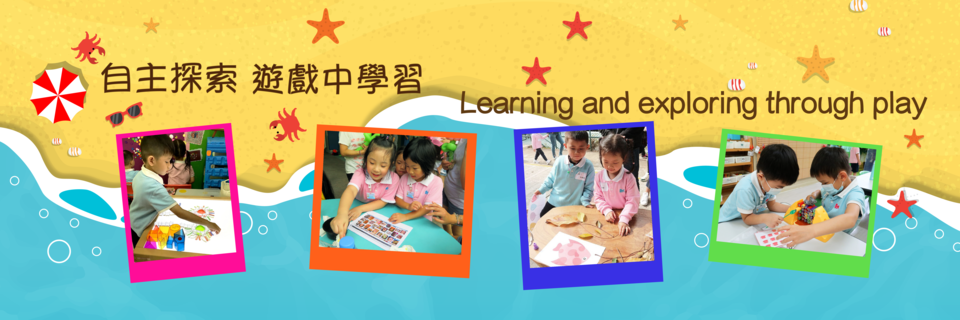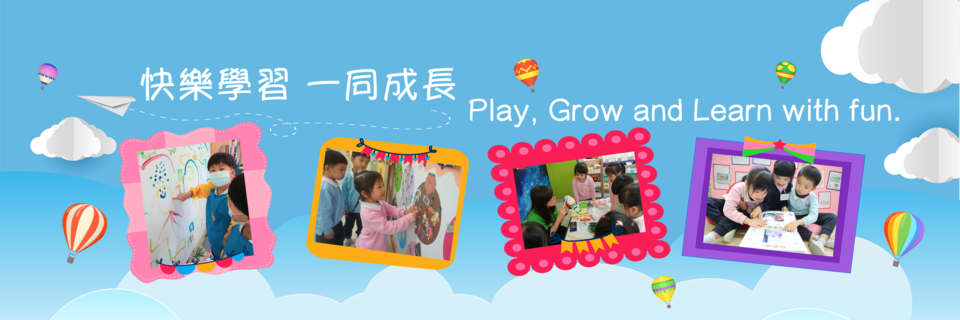Parent Education Activity Information Hub

Topic
Parent-Child Workshop – Play to Develop Executive Functioning
Objectives
- To facilitate parents to understand the basic elements of executive function and its importance for children’s growth and development.
- To let parents and children to experience home-based games that enhance executive functioning.
Details
Have you ever wondered how children can simultaneously follow their teacher’s instructions, sing, and dance? This is the power of *executive functions* at play. Executive functions refer to a set of cognitive abilities managed by the brain's prefrontal cortex. These include skills like impulse control, sustained attention, organization, and planning, which work like an air traffic control system, coordinating and directing multiple tasks. Strong executive functions help children manage and handle various aspects of life, laying the foundation for cognitive, social, emotional, and behavioral development, as well as early academic success.
The ages of 3 to 5 are the golden period for the development of executive functions. Let us work together to support our children in growing and thriving.
Introduction to Home-Based Games:
Game (1): | Teddy Bear and Dinosaur |
Features: |
|
Materials Needed: | Two different types of toys (e.g., a teddy bear and a dinosaur) |
How to Play: |
|
Game: |
|
Game (2): | Matching Pairs |
Features: |
|
Materials Needed: |
|
How to Play: |
|
Game: |
|
This workshop uses these fun and engaging activities to help parents and children strengthen executive functioning while enhancing their connection with one another.
Topic
“Culturing children’s motivation to learn – Parents’ talk” and
“Learning Through Play - Parent-Child Activity"
Objectives
- To facilitate parents to understand early childhood learning patterns.
- To let parents and children to experience various home-based games
- To cultivate children's curiosity and self-care abilities, enhancing their proactive learning.
Details
Throughout the growth process, parents always aspire to nurture their children effectively. How can parents facilitate children to learn effectively? This series of parent talk and parent-child activity will help parents understand how to "learn through play," promoting children's development through daily interactions.
Children primarily learn through "senses," "hands-on activities," and "play." Their natural curiosity can be enhanced with guidance and praise from parents, helping them build a sense of achievement that fosters "active learning."
Introduction to Home-Based Games:
During the games, parents are encouraged to praise and affirm their children's efforts, using phrases that build confidence, such as "You know how to..." and "You observed that..." to motivate children to try new things and learn.
Game 1: | Move Your Hands and Feet |
Suitable Age: | 3 years old or above |
Features: | Strengthens attentiveness, ability to follow instructions, and color recognition |
Materials Needed: | Balloons of different colors, rubber bands |
Gameplay: | Children hold different colored balloons in each hand and follow parents’ instructions to perform corresponding actions, such as raising the red balloon, putting down the green balloon, or not raising the blue balloon. |
Variations: | Attach balloons of different colors to hands and feet; children can sit and listen to instructions, which can also be adapted into English, e.g., "Put the red balloon up/down." |
Game 2: | Number dash |
Suitable Age: | 4 years old or above |
Features: | Strengthens number sense, hand-foot coordination, and working memory |
Preparation: | Parents randomly place papers with numbers 1-9 in a grid format on soft mats (if available) or the floor. |
Gameplay: | Children move their hands and feet according to the numerical order. |
Variations | Odd numbers can only use hands, while even numbers use feet to increase activity levels. |
Safety Reminder: | It is better to have soft mats on the floor when playing for the first time. |
Topic
Parents’ workshop on Family Sexuality Education
Objectives
- Parents are able to learn the strategies of educating their children about the physiological differences between both sexes; dealing with their children’s sexual curiosity; indoctrinating the correct values about sex and enhance the awareness of self-protection.
- Enhance parents’ skills and confident in conducting Family Sexuality Education
Details
- Parents may have a lot of questions regarding family sexuality education, such as how to respond to sex-related questions such as "where do I come from?". This workshop will explain the stages of children's psychosexual development to assist parents in carrying out sexuality education in different stages; share skills and attitudes to deal with children's sexual curiosity, so that parents can educate their children on the correct knowledge of sexuality from an early age.
Four skills to respond to children’s sex-related questions
Skill one: Attentive listening
- Understand meaning behind questions
- Show concern and build-up trust
Skill two: Proper attitude
- Openness
- Encourage questioning
Skill three: Define question(s)
- Clarify the information, confirm the rationale behind the questions
Skill four: Responding skills
- Provide instant, simple answer
- Use the accurate, proper name of sexuality education
- Respond according to the child’s developmental stages
- Make use of teaching materials
Topic
Parent-child learn together: Emotional workshop
Objectives
- Understand different emotions, e.g., joy, sadness, anger, fear.
- Parent-child making emotional handcraft jointly (emotional spinning cups or emotional thermometers) to facilitate children to learn emotional expression by verbal and non-verbal languages
Details
The workshop assists child and parents to understand different emotions and express in a positive way, with the use of picture books and games. When facing children's emotional issues, parents can try to respond with the following five tips to guide their children to regulate their emotions and solve problems, so as to promote their psychological health in long term.
5 skills of responding to children’ emotions
Skill one: Be aware of emotional changes of your child and yourself
Skill two: Shift your perspective to consider the issue as a chance to educate your child
Skill three: Active listening with empathy, understand and accept your child's feelings
Skill four: Assist your child to express emotions/feelings in words
Skill five: Set limits and solve problems with your child
Topic
Gently coping with children’s confrontational behaviors: parents’ workshop
Objectives
- Parents can understand the development needs of children
- Parents can learn the strategies to cope with children’s confrontational behaviors
Details
Having confrontational behaviors, such as refusing to follow adults’ instructions and liking to argue with adults, is common in children’s development. And it is not easy for parents to handle. This workshop aims at working with parents to understand the developmental needs of children and the causes behind confrontational behavior, so that parents can strengthen their parenting skills in handling confrontational behaviors, thereby reducing parents' parenting pressure and improving the parent-child relationship in long term.
Skills to cope with children’s confrontational behaviors
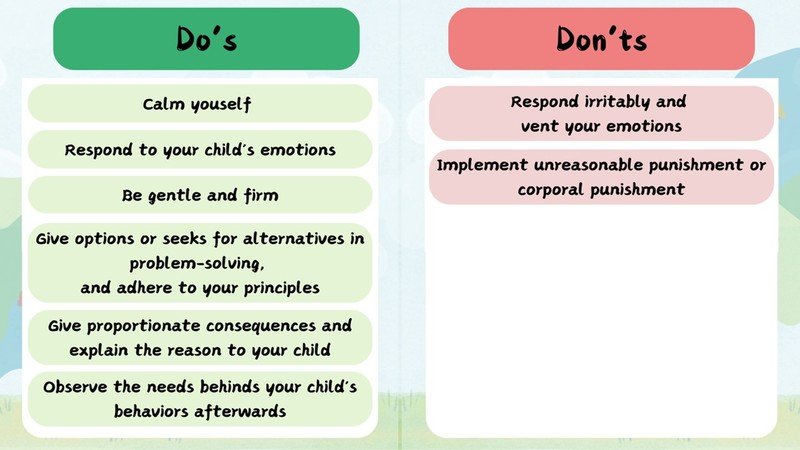
Topic
Happy enrollment: Parents’ talk on supporting children in school adjustment
Objectives
- Parents can understand the changes that their children face when they first admit to kindergarten or nursery, and equip with skills to support them in the adjustment period
- Parents can understand more about home safety
Details
Facing the changes in the environment and separation with caregivers when first admitted to school, each child’s has different adaptation progress and needs, and it is easy for them to have emotions. This workshop mainly facilitates parents to understand the challenges face by children during school admission. Parents can equip with skills to prepare their children for going to school, and deal with separation, striving to support families in adapting to the new stage easily.
Physiological aspects
- Develop a regular schedule, such as a predictable daily routine
- Try more sedentary activities
- Cultivate children’s self-care skills
Psychological aspects
- Develop positive separation experiences
- Use of picture books and puppets to assist children in school adaptation and simulate the separation from parents.
- Use of encouraging wordings to assist children in developing a positive impression of going to school
Topic
“LEGO Six Bricks” Parent-child Workshop: The Skill of Appreciation
Objectives
- Parents can learn the skill of appreciation: immediate, genuine and accurate
Parents and children can communicate with each other through games and enhance their parent-child relationship
Details
Six bricks have six different colors. Parents and children have fun in the games. This workshop mainly introduces the skills of the skill of appreciation (immediate, genuine and accurate). Through language to appreciate children, they are willing to repeat good behavior.
The Skills of Appreciation
Immediate:
Praise your child immediately when he or she does something good
Genuine:
The facial expressions and words should be consistent. Worship the children with a smile and sincere attitude.
Accurate:
Clearly and specifically describe what the child did well
Example: Lily, you are so good (genuine)! You share toys (accurate) with your children today (immediate).
The benefits of appreciation:
- Improve self-esteem
- Increase good behavior
- Show permission
Are We Spoiling Our Kids with Too Much Praise?
- A child who is often praised will...
- Can build confidence to explore and learn
- When self is affirmed, his sense of self-esteem will be stronger
Highlights
Topic
Storytelling PaMa Workshop - Storytelling Skills
Objectives
- Parents can learn to choose a book and storytelling Skills
- Parents can practice the skills learned and increase their confidence in storytelling
Details
Our school organizes the " Storytelling PaMa " volunteer service. We invite parents to tell stories for our students. We hope to bring children joy and cultivate the fun of reading.
This workshop invited the Hans Andersen Club to hold " Storytelling PaMa " storytelling skills talk for parents, including understanding interactive storytelling skills, book appreciation and application, and how to choose books, so as to encourage parents to enhance parent-child relationship through story times.
The Skills of Storytelling Skills
Skill 1: Preparation
Parents should read the story several times before telling their children, so that they can understand the plot of the story and the characteristics of the characters. Before telling a story, it is advisable to choose a quiet and comfortable environment. Parents can arrange a suitable and fixed story time according to the individual situation and needs of the child, for example: before going to bed, provide a relaxing and pleasant story time. A fixed time helps parents and children to develop reading habit.
Skill 2: View the cover of the book
Parents can view the cover of books with their children, arousing their curiosity about the story and interest in reading.
Skill 3:Action expression
When parents tell stories to their children, they should avoid using a bland, boring tone or just tell children directly from the book. This is not only unattractive, but also prevents children from feeling the joy of reading. Also, parents can match with appropriate actions, facial expressions and intonation according to the needs of the plot and characters, so that the children can fully participate in reading. Moreover, please pay attention to avoid emphasizing too many different emotional words in the same story, which confuses children. Parents can emphasize some basic emotions or feelings, such as: happy or unhappy.
How to choose books
Parents may consider choosing books from the following three themes:
1) Daily self-care:
Through the content of the story, children can be taught to master the concepts of self-care, such as bathing, sleeping, going to the toilet, etc.
2) Knowledge Enlightenment:
Children learn some abstract concepts, such as up and down, size, length, and even color, shape, mathematical concepts, etc. These books can focus on guiding children to learn certain concepts and increase children's motivation to learn knowledge.
3) Ideological and moral education:
Children interact with different people in school, which help to nurturing virtues and values. In addition, parents can teach children values through ideological and moral education books.
Highlights
Topic
"Let’s take a deep breath and calm down" Parent-child Workshop -
Emotional Traffic Light Principle
Objectives
Parents can learn to use emotional traffic light as a tool to manage emotions
Children can learn to calm down with mindful breathing games
Details
Mostly, the emotions of parents are easily affected when dealing with children's misbehavior. When emotions become high, we need to stop and think.
This workshop mainly introduces the principle of Emotional Traffic Light. It helps to control emotions and avoid to hurt children. By calming yourself and reflect on the reasons behind the things you feel angry. For example, practice mindful breathing. After calming down, parents can solve and deal with the current problems with their children.
Use emotional traffic light as a tool to manage emotions
Through briefings and videos, staff explain to parents how to deal with emotions under the "Emotional Traffic Light".

Red light - Stop: Take deep breaths and try to calm down
When parents feel angry, they should stop and avoid direct eye contact with their children at once. Try to take a deep breath, drink water, or wash your face to calm down. Avoid out of control behaviors, such as “pushing, hitting the table, throwing things...”. Please allow yourself to leave for a while and be quiet.
Yellow Lights - Reflect: Find a quiet spaces
When parents calm down, give yourself a quiet space and reflect. Try to find out the reasons behind such as "Why are you so angry?", "Is anger useful?", "Does a child's disobedience mean that I am useless?" Why children have responses like that?” Remember to avoid think negatively or catastrophize the current situation. Come up with some positive and effective ways to solve the problem.
Green light - Go: Reconnect with children
Respect is very important when communicate with children. Firstly, parents try to understand the difficulties of their children. Let children express feelings and thoughts. Then, parents respond to their feelings.
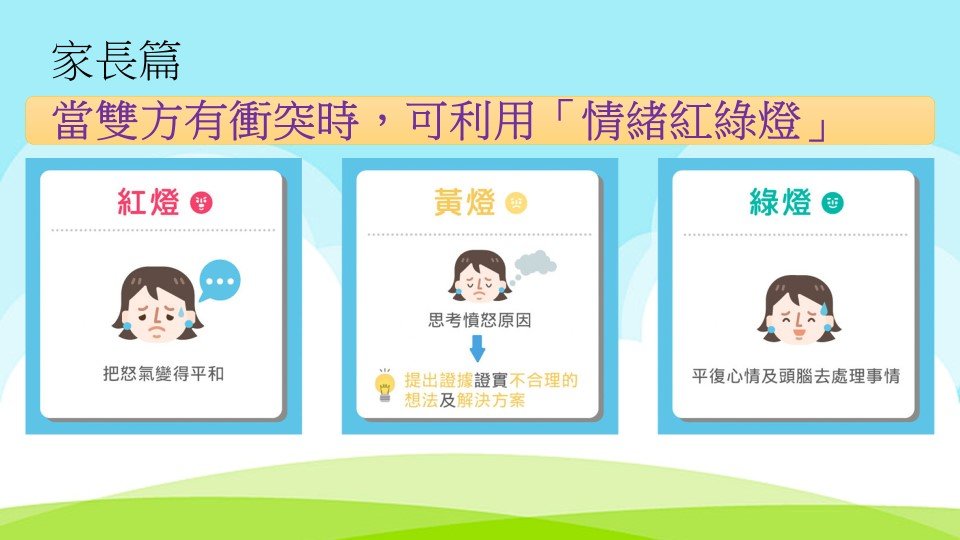

Highlights
Topic
"Always In A Good Mood" Parent-child Workshop - Emotional Response Skills
Objectives
- Learn how to recognize and respond to children’s emotions
- Understand how to calm down by making a magic bottle
- Children can recognize and express four emotions (happy, unhappy, angry and afraid) through games
Details
Parents may have many questions about their children's emotional problems. For example, "Should boys not cry?", "Should I stop my children when they feel angry?", etc. Feelings are not right or wrong, but it's important that children learn to express their emotions appropriately. This workshop mainly introduces the skills of Acknowledge feeling (ACT Model). By expressing their feelings or thoughts, children feel supported and accepted. They are more willing to express their feelings and needs in an appropriate way.
The Skills of Acknowledge Feeling
Parents can actively listen to their children, without judging whether the behavior is right or wrong. When children feel understood, they can calm down more easily. By responding to the child's feelings or thoughts, children feel safe and comfortable.
Example:
Nana came home after school, she felt angry. She said to her mother excitedly: 'Mom, Mandy didn't play with me, I hate her! '
| Respones 1 | Respones 2 |
Mom responded: 'Oh, why do you keep bringing this up? It's not the first time.’ | Mom responded: 'Nana come here, you seem so disappointed! Can you tell me more? ' |
Nana's feeling: From her mother's response, Nana thought that her mother didn't care about her feelings, she felt sad! | Nana's feeling: Mom found out about Nana's disappointment, she felt seen and heard! |
Highlights
Topic
“Tabletop Game for Love Languages” - Parents’ Workshop on Physical Touch
Objectives
- Share the communication skills of “Five Love Languages” to strengthen parent-child relationship
- Introduce to parents a variety of fun tabletop games for them to experience the enjoyment
Details
Everyone has the need to love and be loved, but different people will habitually express and receive love messages through different ways, which is the “language of love”. Every child has an emotional box, a place from where s/he can have replenishment of emotional strength so that s/he can survive the challenges encountered during childhood and adolescence. Adults fill children’s emotional boxes with unconditional love, which can give children a sense of security and hope. Let’s learn together how to use the language of love to fill children’s “Love Box”.
The language of love
Dr. Gary Chapman, the American marriage counseling expert, proposes “five languages” for the expression of love, including physical touch, quality time, words of affirmation, acts of service and receiving gifts.
This workshop mainly introduces “physical touch”. For many children, “physical touch” is the most basic language of love. Upon the birth of a child, our hugs and caresses can bring him/her a sense of security and satisfaction. “Physical touch” refers to meaningful physical contact. Any gentle touch (on hair, the head, the back, arms, shoulders, etc.), hugs, hold, kisses, high fives, horse-riding war games and etc. are all able to enhance intimacy.

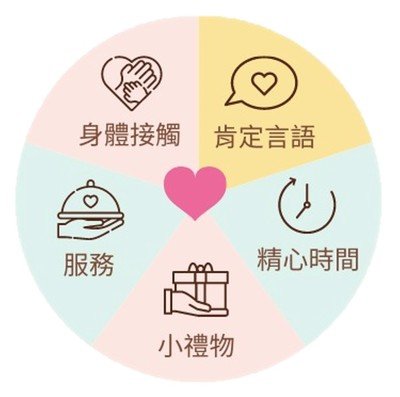
The hugging myth: Will hugging a child lead him/her to develop a bad habit?
Some people worry that hugging a baby each time when it cries will spoil him/her, bringing harm for an inability of independence and allowing him/her to develop a bad habit of sticking to hugs. In fact, hugging will not bring any negative impact at all. When a baby cries, parents should find out the reasons for the crying, such as the need for a sense of security or other reasons.
The Duke University School of Medicine in the United States once conducted a relevant study which discovered that a child’s brain will secrete a kind of “oxytocin” when s/he is hugged by parents. The child will feel being trusted and supported. Those children who are always hugged are more emotionally stable, and have a greater sense of inner security. Hugs are the definite action for parents to establish an intimate relationship with their children. Parents express their love and comfort for their children through hugs.
Highlights

